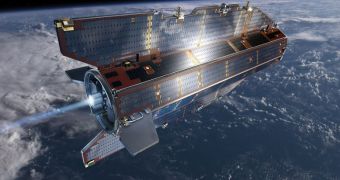Officials at the European Space Agency (ESA) announce that the GOCE satellite has returned to its unusually-low operating orbit, after executing a series of maneuvers to compensate for a glitch that occurred earlier this year.
The Gravity Field and Steady-State Ocean Circulation Explorer spacecraft operates at the incredibly low altitude of 254.9 kilometers, from where it conducts precise gravity measurements.
The main goal of its mission is to determine slight variations in the gravitational pull that areas of the Earth exert on spacecraft. This is something that is incredibly difficult to perform.
GOCE goes about it in a very straightforward manner. It features delicate ion thrusters, which fire just enough to keep the spacecraft at the same altitude at all times.
The engines also fire to compensate for the slight friction that the spacecraft experiences as it rubs against dispersed air molecules, which still linger at its operational altitude.
As it passes over the Earth, the satellite is pulled downwards with varying degrees of strength, depending on the gravitational pull the area it's flying over has.
All of these data are stored in its computers, and then relayed back to Earth. But GOCE experienced an anomaly this July, which prevented it from downloading its data to Earth.
As ESA engineers were working to correct the problem, they raised the spacecraft to an altitude of 263 kilometers. This allowed the engineering teams more rooms to maneuver.
The higher altitude was useful because, if engineers had to shut down the xenon-ion engines, then they would have had more time until the satellite would have begun reentering the atmosphere.
With the telemetry and computer glitches resolved earlier this month, ESA officials decided to lower the satellite to its optimal altitude again, Space reports.
“After working hard to resolve the problem we experienced with the telemetry transmission, it certainly feels good to have the satellite back doing its job of measuring of the gravity field,” said in a statement Rune Floberghagen, who is the GOCE mission manager at ESA.
“I am very happy that the scientific measurements now continue and we can profit from the current low solar activity and measure the best-ever geoid,” says Volker Liebig, who is the director of the ESA Earth Observation Programs.
A geoid is the surface of an ideal global ocean at rest, experts say. After GOCE establishes its shape, the data will be used to measure ocean circulation, sea-level change and ice dynamics.

 14 DAY TRIAL //
14 DAY TRIAL //